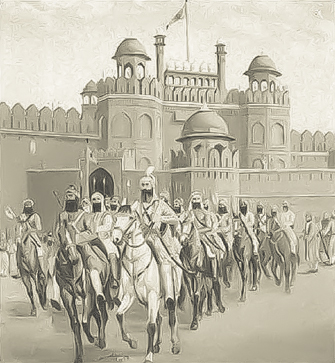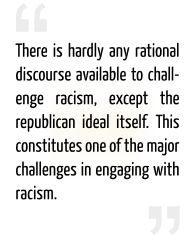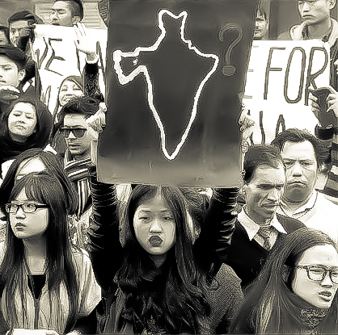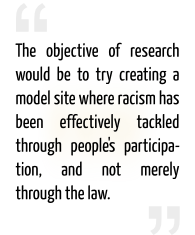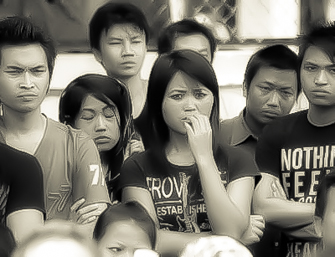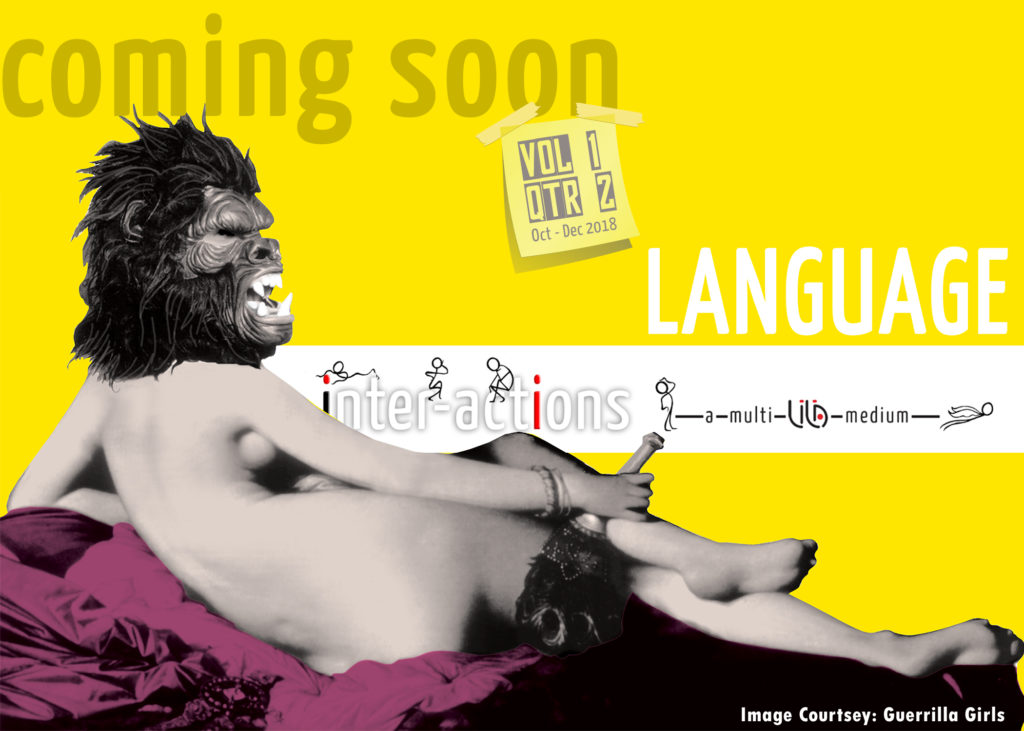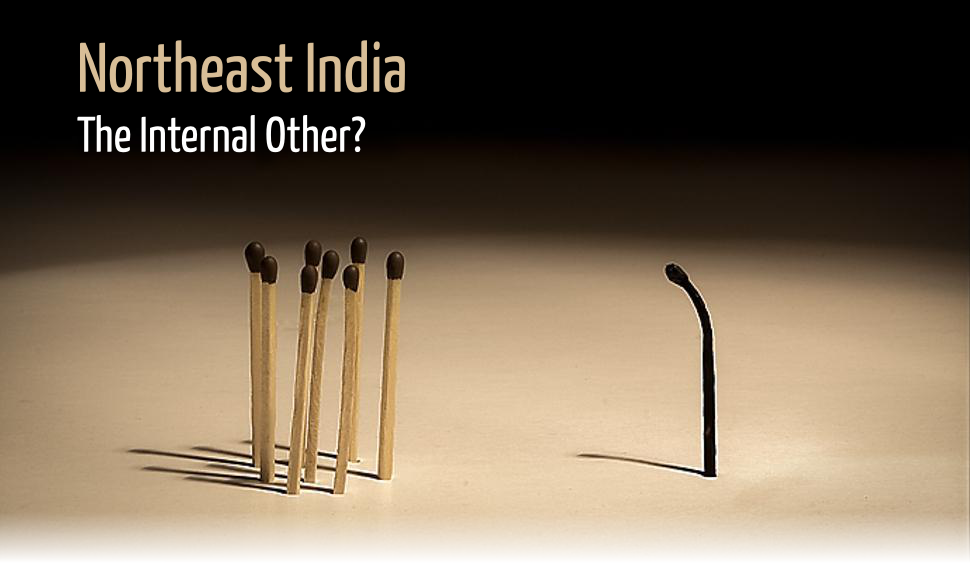
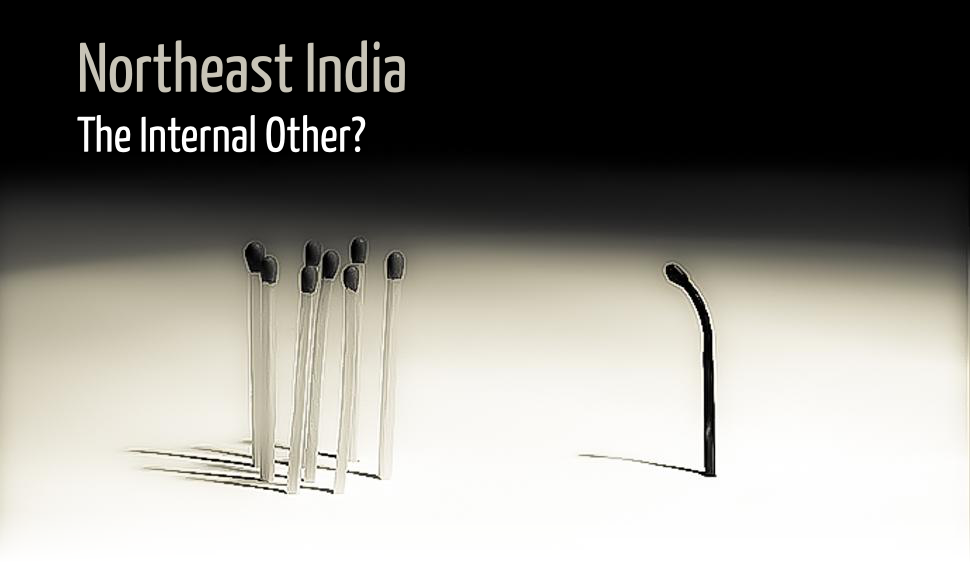
17 February 2014In just a few weeks, a series of attacks on Indians from the North East in various major metros have reminded all of the ever-present threat of racism. Everyday, North East citizens experience the proof that one can be an outsider in one’s own country. Behind racism resides a complex blend of historical ignorance, economic disparities, cultural diversities but also constitutional shortcomings. This week, to tackle the highly intricate and urgent question of racism, LILA Inter-actions welcomes three different societal voices. Journalist and novelist Mitra Phukan discusses the recent socio-economic developments of the North East and calls for a wide sensitisation through culture. Political activist Munish Tamang returns to Sardar Patel to make sense of the apparently intentional isolation in which the North East is still maintained. Finally, scholar Manjeet Baruah regrets the lack of strong conceptual tools against racism, and presents possible educational responses. |
Hold the cursor on the illustrations to display descriptions.
Towards Cultural SensitisationMitra Phukan |
_Continued |
|
It is only after that, after this initial surge of emotion that one takes in the ethnicity. There is, then, this sense of being ‘under siege’. If our children are not safe in the capital of the country, if young people are violated, battered to death in full view of crowds… where can we, people from the North East, go and live safely?
In my understanding, racism is a question of power. When the majority community in a city or town sees somebody from another place, who is either alone, or in a small group, something about the vulnerability of this ‘other’ evokes a ‘bully’ reaction from the majority group. It is the same kind of cruelty that one sees when groups of goons scream with laughter after tying crackers to a dog’s tail and setting them alight. It is very instantaneous; it is not a feeling that is reflected upon. Every racist comment and act comes, eventually, from brutishness. A lack of humanity, of fellow feeling, of simple ordinary human kindness, is behind this. We are cruel people, plain and simple.
Racism arises at the crossing of the differences between the two groups in terms of culture. Looks, cuisine, language, manners… become things that evoke derision, sometimes even fear. It then takes the form of racist comments, and actions. Part of the problem lies in the fact that it is only now that people from this region are going out into the rest of the country in large numbers. The rest of the country is not really familiar with the way we look, or dress. One hopes the ‘strangeness’ will diminish as this region, through the integration of its young people travelling out in ever-larger numbers, integrates with the rest of the country.
Racist acts may be matters of instants, but there are structural backgrounds to the situation at large. The minorities are perceived as being out to grab a slice of the shrinking pie. Truly, the employment situation in India’s North East is abysmal. Decades of insurgency have left the economy in tatters. It is no surprise that young people are going out to study and to work. If they stay here, the youth either sits idle at home, or joins some insurgent group. It is far better that our young people find legitimate work outside the region. It is known that in Indian metropolises, North East citizens are employed in the hospitality sector, beauty salons, restaurants… But I do not think there is anything intrinsically wrong in this. They are earning a living, and there is dignity in any kind of labour. Certainly, Chinese restaurants may hire them for their looks, but they will not be able to retain those jobs based on their looks alone. They will need to be efficient, too. The recent aggressions in Delhi also happen with the backdrop of gender violence. North East women do face a particular type of behaviour in the metros. One must keep in mind that they come from cultures different from those of the North. At home, there is a mingling between the genders in a way that is not seen in the smaller towns of the North. These women carry this mindset with them when they go out of the region, naturally. This independence, this freedom, is often misunderstood by others in parts of the country. It requires some sort of cultural sensitisation.
And that is needed everywhere. The North East carries its own deal of racism. There is a great deal of ‘othering’ within the region itself. Communities look at each other with suspicion, hatred. There are killings. People from outside the region are victims of racist behaviour in many places here. Bengalis living in Meghalaya face a great deal of discrimination in their everyday life. … ↗ |
Non-Bodos living in the Bodo Territorial Area District (BTAD) areas of Assam are very vulnerable to attacks by Bodos. In Assam, ethnic conflicts are now endemic. Racist violence and intolerance of people of other ethnicities is rapidly tearing apart the very fabric of the state.
There is a great amount of ignorance of our culture. When the rest of the country thinks of the North East, it is often within a few boxes: terrorism, exoticism, and, as far as my state goes, floods. The media has a big role to play in this perception. There are many other things that are happening of positive import here, which are not focussed upon. Our history is also not correctly known. I found, to my dismay, that very few people outside the Northeast and Kashmir are aware of the draconian law that is AFSPA. Insurgency left a horrifying legacy in my state. An entire generation of people has grown up in the shadow of the gun, not knowing what ‘normal life’ actually is, or should be. When bombs kill randomly, when trains are blown up routinely, when people are kidnapped, when extortions are daily occurrences… what does it do to the moral fibre of a generation of young people? There is corruption everywhere… deep rooted, systemic. People are cynical, and without hope. This is the legacy of decades of insurgency.
North East citizens are not treated the same everywhere. South India, in general, appears as less racist than the North or even the North East. This, even though they are perceived to be a conservative people. It shows that one does not have to abandon one’s own culture in order to be tolerant of others! In the end, this is what we are looking for, isn’t it? Tolerance, “live and let live”… We have all heard about the ‘unity of India’. As I see it, it is an ambivalent situation. Sure, there is unity in diversity, especially when there is an other who comes from outside India, such as during wars, and international cricket matches. But we are certainly not a homogeneous society internally. And our hostility is hardly veiled. There are deep-rooted enmities between groups. India is racist in a very deep-rooted way. Casteism goes back millennia, does it not? So does the politics of language, and linguistic identity. Even within the same religion, there are factions, and fights. The Hinduism of Assam, for instance, is riven with divisions, and deep hatreds. What can we do today? The anti-racist law is a good start, of course. Laws are all very well, but what about the implementations? Who will implement them? Will our justice system be able to deal with the huge number of cases that will surely come before them? What is also needed is a huge sensitisation process, perhaps through the electronic media, about racism, and its unacceptability in today’s world. The North East is an incredibly diverse region. But the heterogeneity of this region can only be shown through various kinds of mixing, through cultural exchanges, through literary and artistic exposure to the cultures of this region, which are glorious in their diversity. One simple means going a long way is the medium of different ethnic dress. The differences of dress are a good way to show up our heterogeneity. It’s a beginning, at least.
And we must count on art as well. The ‘soft power,’ is important for understanding a people, the culture, the way they think, behave, the way they are. It is through art that we come closer to a people. This is already happening. The Shillong Choir has won many hearts, as have the Tetseo Sisters of Nagaland and many others. Through the luminous beauty of Sattriya dances, through the grace of Manipuri devotional dances, through films, literature, through the unique cuisine of this region, through the wonderful textiles and weaves of this land, we can send out ambassadors to woo and win over the people of the rest of the country. Just as, similarly, the rich and varied cultures of the rest of the country can woo and win over the people of this region, too. In this lies hope. Mitra Phukan is one of the most significant literary voices from the North East of India, and a prominent member of the North East Writers’ Forum. A fiction writer, translator, columnist, and classical vocalist , she lives and works in Guwahati, Assam. Phukan’s critically acclaimed novel The Collector’s Wife is set against the Assam Agitations of the 1970s and 80s. She is a recipient of the UNICEF-CBT award for children’s writing. Her columns are collected as Guwahati Gaze.
|
Debate
The Foundations of SuspicionMunish Tamang |
The Republican BadgeManjeet Baruah |
|
At the outset, I would like to draw the reader’s attention to a significantly different nomenclature that I prefer to use. ‘Indians from the North East’ is more accurate than the largely alienating ‘North Eastern people’. The term ‘North East’ connotes a divide between that part and the rest of India. It also gives a sense of ‘mainland’ India and its adjunct, the ‘North East’. So there is this constant rhetoric of ‘integrating North East with the mainstream’ which, at best, is a very condescending approach to the issue.
Of course, the othering emerges from both sides. It is ‘dhoti’ versus ‘chinky’ in equal measure. A simmering hostility waits to flare up at any instance. At the root of it all is the deep-seated suspicion, equally shared on both sides. I would argue that this suspicion has been nourished and encouraged by the administrators and policy framers right from the time of Independence, and has been perpetuated through academic and popular writings, fictional representations, and films.
In his letter of the 7th November 1950 to Prime Minister Nehru, Sardar Patel assesses the threat perceptions to the newly Independent India. He writes some of the most damning lines on the North-Eastern region: All along the Himalayas in the North and North-East, we have on our side of the frontier a population ethnologically and culturally not different from Tibetans and Mongoloids. The undefined state of the frontier and the existence on our side of a population with its affinities to the Tibetans or Chinese have all the elements of the potential trouble between China and ourselves … Let us also consider the political conditions on this potentially troublesome frontier. Our Northern and North-Eastern approaches consist of Nepal, Bhutan, Sikkim, Darjeeling and the tribal areas in Assam … The people inhabiting these portions have no established loyalty or devotion to India. Even Darjeeling and Kalimpong areas are not free from pro-Mongoloid prejudices.
Patel does not offer any instance to substantiate his claim that the people of this region are less loyal to India. He does not feel the need to. For him, it is an undisputed fact – people who are “ethnologically and culturally” different from us cannot be loyal to the country. With such a foundation laid by the founding fathers, it is no surprise that the Indian edifice would be made of successive discourses built on suspicion and discrimination, based on linguistic, ethnic, and cultural differences.
Following this analysis, Patel puts forward his ten-point suggestions on handling the threats. Typical of the ‘iron man’, he does not believe in addressing the ‘loyalty’ problem that he perceives in the North-East. For him, the solution lies in such things as ‘redisposition of our forces’ and administrative steps to militarily ‘strengthen’ the frontier. The strategy is simple: in order to build a strong India, identify the ones who are ‘different’, investigate their ‘loyalty’, treat them as suspects, and increase administrative and military control over them. That is the cornerstone of a racist administrative mindset of which the North-East part of India has been a victim.
What happens when such people as the ones with suspect loyalties raise their voice as a matter of right? The template reaction is to see it as disruptive, secessionist, and a threat to national security and integration. So, a genuine people’s movement for the creation of Gorkhaland within India under Article 3(A) of the Indian Constitution becomes for the then Chief Minister of Bengal, Jyoti Basu, a ‘separatist movement’. Not very surprisingly, in Kiran Desai’s Booker winning Inheritance of Loss the movement finds description as an ‘insurgency’. That one does not need to back one’s suspicion with research while questioning the loyalties of the people in the ‘frontiers’ is shockingly displayed in the recent Gorkhaland: Crisis of Statehood by Romit Bagchi. Like many policy thinkers, Bagchi, too, is haunted by the imaginary ghost of the Greater Nepal conspiracy. While referring to this machination, all Bagchi has to offer in the footnote as a matter of research is a casual conversation that he had with some professor from North Bengal University. While being a travesty of footnoting and research gathering, the observation is also an example of one baseless suspicion corroborating another. Given such a foundation of suspicion, it is not difficult to understand the racist response that Indians from the North East face in other parts of India. They are definitely the other with a serious potential to damage the fabric of India – morally, politically, and culturally. Engagement with them can only be at the superficial level – ‘Oh, people from the North East are pleasant and soft spoken’, ‘they have smiling faces’ etc. All is well as long as the North East gives a reassuring smile of consent. Mamata Banerjee is happy to announce at press conferences in Kolkata that “Kanchenjunga is smiling” while simultaneously threatening in public meetings in Darjeeling that she is a very ‘rough and tough Chief Minister’. In a democratic, multicultural India, some people are only entitled to smile. ‘Only smile, don’t speak’. Because the moment they speak, it disturbs the peace of the country. The superhit Ranbir starrer Burfi depicted it very well. Set in Darjeeling, the story of character Burfi is pretty much the story of Darjeeling and its people. Like Burfi, Darjeeling is happy, charming but voiceless and has no power to narrate its own story. Framed by corrupt power brokers and officials, Burfi is desired by the powerful Kolkattans who want to possess it, but cannot take the plunge to redeem it. Like in the film, poor deaf and mute Darjeeling can only find its happiness with other special, forsaken children of God.
So, as long as the North East is tucked away in the Himalayas, as long as it retains its designated space in the folkloric diversity of India, as long as there is mutual isolation, there will be no case of racism in India. It is only in vying for a multicultural space in Lajpat Nagar or Munirka that the spirit of Patel will remind us of our loyalties and then the ugly head of racism will raise its dormant head. Until then, there is no racism in India. |
Delhi is particularly notorious for such racial prejudice. There is often a tendency to explain Delhi’s infamous character in terms of its history of invasion, and the social and political violence that went with it. But this is also where questions of modern republican ideals and morality become important. If those values, as enshrined in the Constitution, are meant to form a conceptual break from the past, then the futility of any recourse to historical explanations must be emphasised. Rather than some historical narrative, we must highlight the issue of race more specifically, vis-à-vis actual cases, for example Nido Tania’s death. The violence against those from North East India is part of a larger set of racist violence in the country, engulfing various groups of different ‘racial’ background.
Because the republican conceptual break was enshrined in the Constitution, the need to leave the past became part of educational discourses too. Therefore, it became an integral part of the educational rhetoric, right from the start, that communalism or casteism go against these very ideals. As a result, rational discourses became readily available to challenge such forms of violence, both theoretically and empirically. Even a cursory observation would suffice to show how our everyday politics against such violence is significantly informed by these discourses. But there is hardly any such discourse available to challenge racism, except the republican ideal itself. This constitutes one of the major challenges in engaging with racism. Racism, as we understand it, must be distinguished from ethnic or language and region based distinctions. In other words, the identity-driven politics of any region in India must be distinguished from the racism it may be associated with. It is only then that one can begin explaining the fury of violence directed in many parts of India against Africans and North East citizens, against groups from the Himalayan zone and others from East Asia. Similarly, one may say that tensions stemming from identity politics between an English and a Scot are different from identity-based discourses setting them vis-à-vis South Asian or East Asian groups. Without that distinction, the problem of racism gets lost in the general issues of economic and social violence.
Many studies have shown that the North East region is a periphery not only in terms of geography. It is also a periphery to the dominant image of caste, race and religion in India. Geography is only an additive factor in this regard. How can one tackle this problem? One must acknowledge, first, that within the North East, no strong knowledge discourse has emerged to theoretically or empirically challenge racism. In fact, by privileging the ‘ethnic’ to understand the people and the region, the existing knowledge systems have succeeded in removing the possibility of discourses actually challenging identity-based constructs. Ironically, those engaged in the production of such discourses criticize identity politics! Due to this lack, when people venture beyond the region, into what is popularly called ‘mainland India’, they have nothing other than the badge of republican ideals to engage with the local people in matters of racism. As a result, there is also hardly any scope for those from the region to participate in a common front against the various ‘isms’ that challenge our republican ideals. This absence of knowledge discourse is also the reason why those from ‘mainland India’, even when progressive, are often left clueless as to how to understand racism. This is possibly another reflection of the fact that the dominant modes of knowledge production in India are caste, race and religion-based, even when one tries to critique those very norms from rationalist perspectives. The point I wish to make here is that knowledge is not removed from organised or everyday politics. Both are closely connected. If racism is a major problem of India today, it must be connected to the fact that there is also a failure of the knowledge production itself in this regard.
How can we transcend the lack of such effective knowledge discourses? Of the several different ways available to enter this engagement, I would mention only two. Both happen to be related to my professional world. First, along with protest, there is a need to constructively engage with social change on racism. This is where the role of action research becomes crucial. The research engagement on local people would have to be with them and through them, to bring about social change on the question of racism. Based on identified colonies, communities or villages, the objective of research would be to try creating a model site where racism has been effectively tackled through people’s participation, and not merely through the law. The model site could be an experiment showing how a group can create the conditions to bring forth a strong social will behind law. This is one way universities can constructively engage with their surroundings.
Second, there is an urgent need to develop teaching programmes at various levels to engage learners with issues of racism. What would lie at the heart of such programmes are universal human values, and these values are essential to overcome various kinds of historical, political or cultural intolerances. It is a long journey. But it has to start now. In fact, limited beginnings have already been made in a few universities. The need is its further promotion. |
|
Munish Tamang teaches in the English Department of Motilal Nehru College, Delhi University. He is the General Secretary of Bharatiya Gorkha Parisangh, a national organisation representing about 10 million Indian Gorkhas. He is also the General Secretary of Gorkhaland Task Force, an alliance of various political and social organisations committed to the creation of Gorkhaland.
|
Manjeet Baruah is faculty in the North East India Studies Programme, Jawaharlal Nehru University, New Delhi. His areas of interest include cultural history and studies of borderlands. Among his recent published works is Frontier Cultures: A Social History of Assamese Literature (Routledge, 2012). His short stories and translations have appeared in several forums, including the Indian Literature (Sahitya Akademi, New Delhi).
|
Disclaimers: The opinions expressed by the writers are their own. They do not represent their institutions’ view.
LILA Inter-actions will not be responsible for the views presented.
The images and the videos used are only intended to provide multiple perspectives on the fields under discussion.
Images courtesy: Abdul-Aziz | Sify | Ritu Raj Konwar | INPEC | Indian Embassy | Hindu Jagruti | Indi Leak | Apna Time Pass | The Times of India | Face N Facts
Share this debate… |
… follow LILA… |
||||

 Nido Tania in Lajpat Nagar, Ginkhansuan Naulak and Vumsu-anmung Naulak in Ambedkar Nagar, Ksupsi-kren in Lajpat Nagar and the young Manipuri girl in Munirka… The first emotion on hearing of such incidents is always a deep sense of sadness, and anger. These are young lives, cut off in the prime of youth. The sentiment is the same, regardless of the ethnicity of the victim. There is compassion for the bereaved family members. But also anger against the law enforcement agencies. What were they doing, why could they not prevent this horror from taking place? What went wrong?
Nido Tania in Lajpat Nagar, Ginkhansuan Naulak and Vumsu-anmung Naulak in Ambedkar Nagar, Ksupsi-kren in Lajpat Nagar and the young Manipuri girl in Munirka… The first emotion on hearing of such incidents is always a deep sense of sadness, and anger. These are young lives, cut off in the prime of youth. The sentiment is the same, regardless of the ethnicity of the victim. There is compassion for the bereaved family members. But also anger against the law enforcement agencies. What were they doing, why could they not prevent this horror from taking place? What went wrong?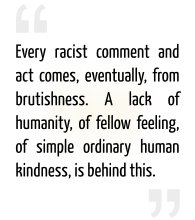
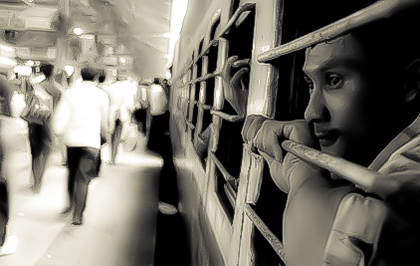
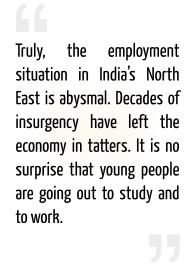
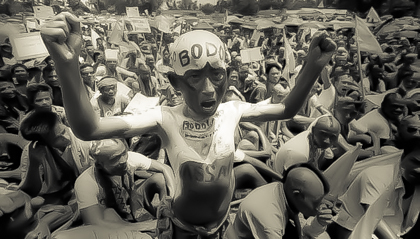
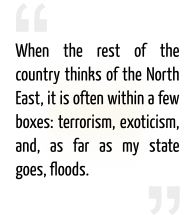
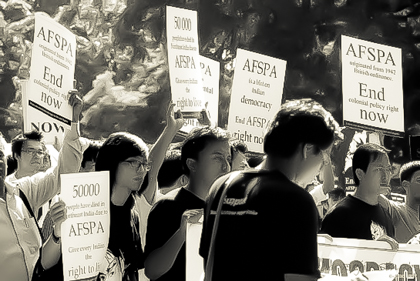

 The long standing racist and discriminatory attitude towards Indians from the North-Eastern part of the country is nothing but a classic reaction to the ‘other’. After all, one cannot be a racist against one’s own. The problem here is compounded with the fact that this other happens to be in an extremely vulnerable position, owing to its lack of access to political and power discourses.
The long standing racist and discriminatory attitude towards Indians from the North-Eastern part of the country is nothing but a classic reaction to the ‘other’. After all, one cannot be a racist against one’s own. The problem here is compounded with the fact that this other happens to be in an extremely vulnerable position, owing to its lack of access to political and power discourses.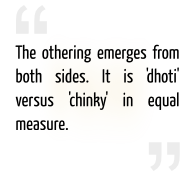
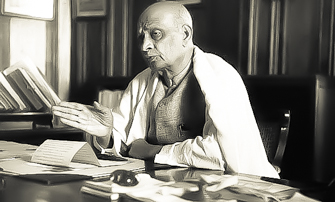
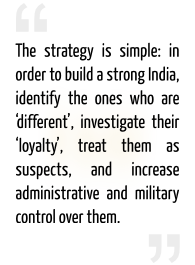
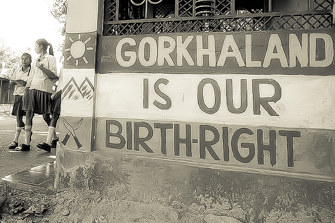

 As noted by Mitra baideo, the death of Nido Tania is only one in many cases of violence committed on people judged culturally or ‘racially’ different from the population staying where they reside. In this category of the racially different, even people from Africa, the Himalayan zone and East Asia must be included. Death or other forms of extreme violence (such as rape) are only the tip of the iceberg. The innumerable cases of harassment in the everyday lives, as experienced by the racially ‘different’ in many parts of India, are an untold harrowing experience. In fact, the irony is that such everyday harassment has even become ‘normal’ in the discourse of urban life.
As noted by Mitra baideo, the death of Nido Tania is only one in many cases of violence committed on people judged culturally or ‘racially’ different from the population staying where they reside. In this category of the racially different, even people from Africa, the Himalayan zone and East Asia must be included. Death or other forms of extreme violence (such as rape) are only the tip of the iceberg. The innumerable cases of harassment in the everyday lives, as experienced by the racially ‘different’ in many parts of India, are an untold harrowing experience. In fact, the irony is that such everyday harassment has even become ‘normal’ in the discourse of urban life.